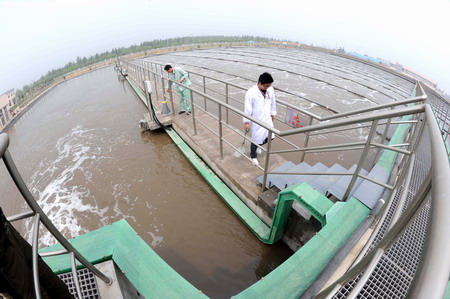Society
Pollution hinders South-to North water diversion
By LIANG CHAO (China Daily)
Updated: 2010-07-06 07:42
 |
Large Medium Small |
|
 The Dapu sewage treatment plant in Lianyungang city, Jiangsu province, begins operations on May 17. The plant is located on the South-to-North Water Diversion project's eastern route and can process 100,000 tons of sewage every day. [China Daily] |
Tengzhou, Shandong - Authorities are still struggling with concerns about the poor water quality of the eastern route of the South-to-North Water Diversion (SNWD) project eight years after the eastern route's construction began.
A State Council-approved directive issued before the eastern route's construction required local authorities to ensure the water quality is at least Grade 3, the minimum standard for water that is drinkable after treatment.
Director of the SNWD office under the State Council Zhang Jiyao said: "There is still a long way to go before local authorities transform the eastern route into a clean-water corridor and ensure the quality won't decline again."
The construction of key pollution-control facilities is slated for the end of this year, Zhang said on Monday.
The facilities include manmade wetlands, which will purify urban waste water, and pipelines linking urban sewage treatment plants, he said.
Measures will prioritize curbing pollution caused by irregular aquaculture, rural sewage and small shipping wharfs scattered along the Grand Canal near the eastern route.
Zhang urged local authorities to monitor pollution upstream of the Dangjiangkou Reservoir - the water supply source of the SNWD's central route - to prevent pollution from entering the reservoir or contaminating its under-construction trunk canal.
The SNWD project will take water from the massive Yangtze River in the South to satisfy demand in the North's drought-prone cities, such as Beijing and Tianjin. The eastern, central and western routes will each stretch more than 1,000 km.
Construction began on the eastern route in 2002 and a year later on the central route. The eastern route is still on the drawing board and is scheduled for completion by 2013.
The eastern route's first phase involves improving canals to connect river systems to channel water mainly through Jiangsu and Shandong - the two provinces along the route with the worst water pollution - to Tianjin.
All 426 pollution control projects have broken ground, and 399, or 94 percent, of them have been completed, Zhang's office reported. Two-thirds of them are operating at more than 80 percent of capacity.
The new industrial pollution control facilities have also achieved more than 90 percent of the standard for sewage discharge .
Testing in the first quarter found water quality is at least Grade 3 in 23 trunk canals, or 66 percent of the sections planned for the eastern route south of the Yellow River.



